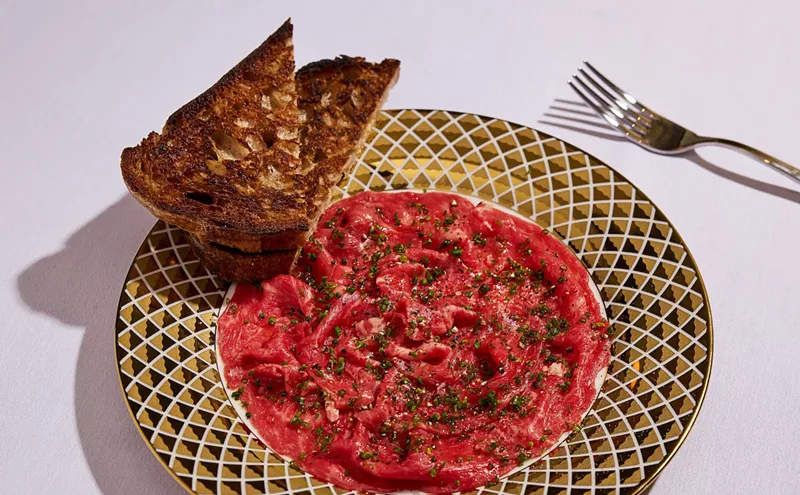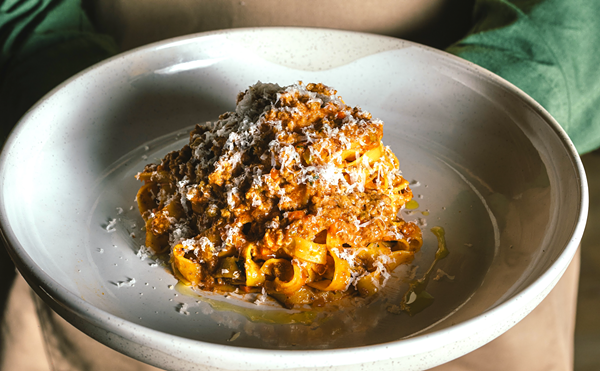High-quality fast food continues to be American gastronomy's answer to 21st-century economics and tastes. We're not referring to chains such as Chipotle and its ilk, but rather local, independently owned operations that put out limited menus of global street foods prepared with high-level ingredients and skill. The precursor to this national culinary craze manifested itself in these parts via an explosion of "gourmet" pizza and hamburger joints. Now the gastro trucks, originally popularized years ago in L.A., have pulled into our eager little town, as have the new generation of ethnic counter-service eateries such as Wok Town and Sakaya Kitchen. The latter debuted in the Shops at Midtown Miami last December and exemplifies all that is worthy in this trend.
Chef/owner Richard Hales, a graduate of the French Culinary Institute, got the inspiration for Sakaya while working under the iconic Jean-Georges Vongerichten in New York. Before jumping in with a place of his own, however, Hales furthered his chops as opening chef of the Asian station at Café Sambal in the Mandarin Oriental Miami. You can see the tattooed chef behind the counter at Sakaya just about anytime you visit. You won't find that at Chipotle.
That counter, wide and stainless, is where Sakaya's action happens; orders are taken, money is exchanged, and behind it the food gets prepared. The rest of the clean, well-lighted space has about 20 seats (and 32 under orange umbrellas outside) and a blackboard wall where pertinent info is chalked — menus, drink specials, the restaurant's green credentials (recyclable materials, etc.). A couple of New Times' Short Order accolades are posted by the entrance.
Sakaya serves a concise menu of casual Asian/Southeast Asian fare such as Filipino egg rolls, Japanese miso soup, Vietnamese bao (steamed buns), and a predominance of Korean street foods such as kimchi, bulgogi wraps, and spicy chicken wings. Natural meat, poultry, and seafoods are used, along with organic dairy and produce, some of which comes from local farms. All menu items are made from scratch, including the curing of meats, pickling of vegetables, and preparation of ssams, ssamjangs, and such. As with many of today's "new" fast foods, the cooking process tends to be really slow.
Take the pork buns. A bone-in Boston butt marinates for 24 hours in a blend that includes brown sugar, toasted spices, and sesame oil and then roasts for another eight hours. The resultant meat, which tastes like a scrumptious cross between pork belly and brisket, gets folded between steamy, soft white buns with slices of pickled cucumber and a drizzle of sweet chili sauce. Take the pork buns as a starter, and then take more in a container to go. If you live nearby, you might be tempted to get them often.
Pork, this time shredded, gets mixed with shrimp, sprouts, and vegetables in crackly "Papa's" egg rolls ("Papa" being Hales's nickname for his Filipino grandmother). The dipping sauce is a sweet, peppery toss of rice wine vinegar and soy. The rolls are finger-lickin' good — crisp, meaty, and addictively delectable.
Same goes for the Korean chicken wings. The "hot" version gets marinated with more of the Korean chili paste called kochujang. You can order either rendition piecemeal (6 for $5.49, 12 for $9.99, 20 for $16.99) or as a dinner comprising six wings with notably flavorful jasmine rice, kimchi, and the pickled cukes ($8.49). Sakaya's à la carte kimchi, incidentally, comes culled from either Napa cabbage or bok choy, each trumpeting a hot, tangy taste.
Need something to smooth the spiciness? Sakaya is the Japanese term for "sake shop," and Hales, the former sommelier at Azul (!), has started with a select group of about a half-dozen bottles; the Japanese beers go well with this food too.
More kudos for the baby-back ribs, seductively coated with a glaze of honey and orange tinged with star anise. Bulgogi wraps (or ssam) bring a short stack of local Swank Farms butterhead Bibb lettuce to be rolled around grilled slabs of Angus hanger steak. Rice, bean sprouts, and the Korean coupling of kimchi and ssamjang are served alongside. Even a side order of green beans was alluringly gingered. In fact, the only missed note during our visits was the egg noodles with tofu and ginger scallion sauce — a bland, forgettable version.
Dim ssam Sunday brunch is thoroughly distinct from those served elsewhere. Unlike other meal periods at Sakaya, it is not self-serve, so the counter crew gets to tackle wait skills. A few kinks need to be ironed out, but brunch here is new. The food needs no such fine-tuning. A crunchy scallion waffle topped with Korean fried chicken brings a brash, sweet (maple)/spicy spin on the old soul food concept. We also liked a savory filled Korean pancake that is more egg than flour — and as such has more in common with egg foo young, okonomiyaki, and matzo brei than anything from Aunt Jemima. It's also tastier, with crisp pork bits, scallions, and daikon kimchi stuffed inside and piquant, paprika-colored ssamjang sauce drizzled on top. If those are not enough potent flavors for your meal, maybe you'd care for a side of "Korean dog" — a mini hot dog with purple slaw, scallion kimchi, and sesame-flecked cream (just $1.50, so make it two).
Brunch also brings banchan (one order usually comprising about seven small side plates such as dried cuttlefish and anchovies, marinated tofu, a couple of kimchi); an assortment of à la carte ssam (rolled with roast pork, calamari, fried popcorn shrimp, or the Angus beef — play it again, ssam!); and more bao. So, on Sundays, you can enjoy not only a pork bun but also a spicy soft-shell crab bun and a show-stopping, mind-blowing banh mi bao of house-cured pork belly and duck pâté cut with carrot kimchi, ssamjang mayo, and cilantro. They're $4.49 apiece, so figure if you ate ten of them for dinner (easily done), it would be the best $45 meal you've had in a while — plus whatever you'd spend on sake.
Serious culinary thrills without the frills: The future is here, and we like it.












